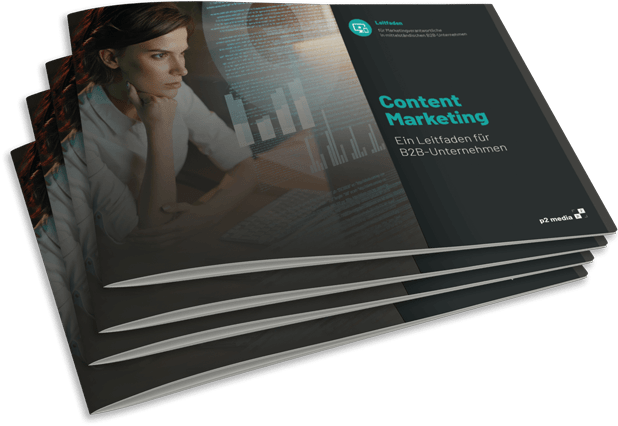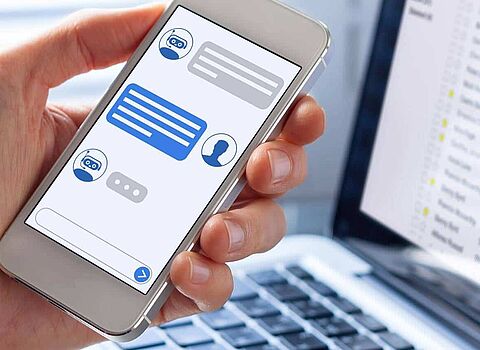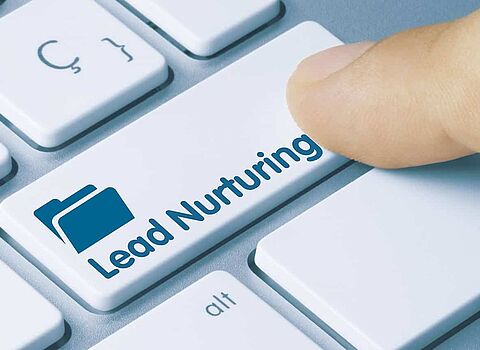B2B lead generation is the process of acquiring prospects who have what it takes to become potential new customers. A "lead" is someone who - for example through an inquiry, a download or perhaps even the use of a service of the company - has already expressed interest in the offer and whose contact details are already known to the company. Leads can be generated primarily through various B2B marketing measures. In the past, these were mainly classic measures such as trade fair appearances, advertising measures or events, where companies relied on to acquire new customers. In the meantime, however, digital marketing in particular is promising in lead generation. Digital marketing has the advantage that it is usually cheaper to carry out than the classic B2B measures for generating leads. Moreover, it is also very accommodating to customer behavior. While, for example, in many B2B industries trade fair visitors are becoming fewer and fewer and printed catalogues no longer attract as many orders and thus fewer leads can be generated, the focus in lead generation today is on the digital presence: content marketing, newsletters, user-friendly and service-oriented websites or online shops are a must for lead generation and new customer acquisition.
Inbound marketing is the keyword for new customer acquisition: instead of searching for customers themselves, medium-sized B2B companies today can and should focus more on being found by prospects themselves and doing everything they can to ensure that the company's external image picks up, appeals to and wins over potential new customers. After all, the information sovereignty nowadays no longer lies with the companies, but with the customers themselves. With the right management to generate leads and appropriately prepared content, insights can be gained that help in the acquisition of new customers.
Inbound Marketing:
Attracting self-determined customers to you
Customers - especially at the beginning of the buying process - increasingly prefer to find out for themselves what a company has to offer them. For this purpose, a well-managed homepage and / or a corresponding web shop is indispensable. The sales department only comes into play later in the buying process - if at all - by verifying the needs analysis of the informed customer collected by lead management, advising him and submitting an offer. Most customers have already informed themselves sufficiently and often only contact a company when they have already decided what they need - 60 percent of the buying process is then already complete. Especially in B2B, acquiring new customers from prospects is often about long-term investment and trust. Here, in the course of inbound marketing, a service-oriented, professional B2B website is worth its weight in gold, especially for medium-sized companies. For the findability in search engines, this is also advantageous. Especially small and medium-sized companies that have specialized have a good chance of landing high in the search result lists for their niche topic on Google through a well-structured, customer-friendly and further SEO-optimized site, in order to be able to achieve lead generation. Moreover, tracking and analytics tools help in B2B lead generation and new customer acquisition as potential leads make their presence felt digitally even before the first face-to-face contact. Behaviors and preferences of website users and prospects can be determined efficiently and cost-effectively with lead management strategies and thanks to digital trails. This can be done, for example, by evaluating clicks and downloads, customer login profiles for service offers and other tools. In this way, lead profiles can be created and content marketing measures such as personally tailored offers can be placed in a targeted manner, which significantly increases the chances of success of achieving good lead generation.
Utilize potentials for new customer acquisition with lead management
In order to convert the lead into a buyer as quickly as possible after lead generation, thelead management comes into play. In lead management, it is important to correctly assess the needs of the lead and to decide on the appropriate strategy without immediately beating the first delicate bonds of the customer relationship to death with the sales club. To do this, it is worth knowing a few basics about lead management. A first step in lead management for generating new customers from prospects is to divide leads into different categories that say something about their status and whether they are already ripe to be referred to sales. Experts often distinguish between:
In lead management, marketing qualified leads are interested parties who have already established contact with the company, so that, for example, in addition to the name, the telephone number, email address or postal address is known. Through the knowledge of the touchpoint, i.e. on which topic or which opportunity or inquiry the contact arose, further clues can be collected with the help of lead scoring (see below) as a lead management measure in order to bring the lead to the next level and make it a sales accepted lead.
Sales Accepted Leads are potential customers/interested parties who are already clearly seeking a solution to a specific problem. They have - e.g. due to inbound marketing measures - looked at or searched for specific content on your B2B website several times in a targeted manner, used product-related content (read articles, downloaded content, etc.). In order to be able to successfully take the next steps to acquire new customers after lead generation, the sales department for new customer acquisition in the B2B area should ideally receive, in addition to name and customer contact data, information about which company the lead works for and in which function, whether the lead can make purchasing decisions and which content was of particular interest to him. Obtaining this information unobtrusively is still the task of marketing using lead management.
Sales Qualified Leads are the "ripe fruits" in lead generation that need to be picked without spoiling them by too much pressure. They are not a case for further B2B content marketing measures, but for sales: They have clearly shown an initial interest in buying, which must now be cleverly nurtured. Sales Qualified Leads have already come into contact with your company and expressed an interest in the product or service. Ideally, you know from this lead what budget is available, that he is responsible for the purchase decision, what he wants from the product or service and when he needs it. To ensure that a contract is actually signed after lead generation, it is important to show tact. For example, general advertising measures could be suspended for leads at this stage, which could unnecessarily dilute an already personal customer relationship at this level to arbitrariness. Together with the lead, the next marketing steps can be agreed upon as concretely as possible - for example, a test offer followed by a joint evaluation - in order to carefully but firmly conclude a contract.
Lead nurturing is then about learning more about your leads to build a profile, gain data for lead scoring and ultimately guide them through the buying process in a more targeted way. What topics, services or products on your B2B website are your lead most interested in? - Offer him targeted, useful information (not to be confused with advertising!) on that topic that adds value when he reads, views or downloads it; this builds trust. What search terms does he enter, and what can be inferred from them? - On the one hand, there are automated marketing tools here, but on the other hand, content analyses can also help.
Byer Personas: Who are your ideal customers?
A central concept in B2B inbound marketing, which also plays a major role in lead management, is the buyer persona: buyer personas are the ideal customers for your product that they would want and that you want to win over at all costs. In doing so, you don't need to wait and hope that these ideal customers will discover your company for themselves - with active lead management, they can find your ideal customers through lead generation. To turn a lead into a buyer, there are different approaches and communication strategies for B2B companies. You should take into account the personality of the desired customers, pick them up at the right point in the buying process and collect sufficient information about their needs and wishes with marketing measures. To discover the needs of your prospects, get to know them better and generate leads, the first step is to develop buyer personas models and ask yourself who your target group is. This can be done in a workshop, for example, ideally with the employees who most frequently interact with customers. In doing so, you could gradually get closer to the buyer persona and create a profile (or several profiles). Picture your prospect:
- What is this person's job position?
- What does he look like?
- How old is he or she?
- What interests / hobbies would she have?
- What would be typical statements this person would make, what are their values?
- What are their expectations of products or services?
- How and where would she get information about them?
These and more detailed questions result in an overall profile that you can refer back to again and again in lead generation and content marketing measures.
A potential customer discovers a need for which he is looking for a solution. In the best case, he already finds your company (e.g. the website or the webshop) that can offer him a solution. Inbound B2B marketing measures such as search engine optimized website texts, Google Ads or content marketing can help your company to be found and generate leads.
The potential customer is about to make a purchase decision - this is where your sales department comes in: Can they correctly assess the customer's personality based on the data collected and the profile created, and can they influence the emotional decision-making process by acting accordingly? While some types of customers rather need accompanying B2B advice for decision-making, others attach great importance to their freedom of decision and rather need suggestive decision support.
Der Interessent hat recherchiert und filtert die besten Angebote heraus, die ihm eine Lösung anbieten können. In dieser Phase kann es sein, dass er Ihr Unternehmen bereits kontaktiert. In diesem Fall sollten Sie Ihre Buyer Persona bzw. ihre Zielgruppe für die Leadgenerierung gut kennen: Worauf achten sie besonders, was Sie ihnen bieten können?
Lead scoring:
How do I filter out actual potential customers from leads?
Lead scoring is about evaluating the collected data of the leads and developing a scoring / point system at which point a lead is most likely to become a customer or a so-called sales accepted lead. The data can be implicit and explicit in nature. The latter is provided by the customer himself, for example when he fills out a contact form to benefit from a service (e.g. download, login, newsletter, etc.) Implicit data is the tracked data:
- What does he download?
- Which articles does he look at?
- Which search terms does he enter?
- Which pages does he visit?
For each piece of data, from the job title to the phone number to the newsletter open and click rate, you give a certain number of points. Only when the lead has reached a certain number of points / score and is therefore a strong potential customer, it is forwarded from marketing to sales.
Our support around the topic of lead management:
The generation of high-quality leads forms a significant key factor for long-term business success in B2B and B2C marketing.
- We develop and implement successful lead generation concepts to make the most of your potential and create the right conditions for efficient and personalised marketing measures.
- We support you in first defining and analysing your optimal target groups and then using relevant content to reach them exactly where they are digitally.
- Together with you, we develop a practicalnurturing process to generate qualitative leads along the entire customer journey.
If desired, we will be happy to implement amarketing automation solution that complies with data protection regulations - support in both the selection of the right software and the implementation and monitoring of your campaigns.
Oliver Parrizas will be happy to answer any questions you may have on the subject. +49-800-911-91-91











